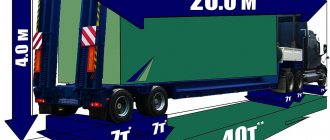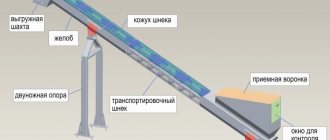Fire, explosion, leakage of radioactive substances - these are the possible damages that can result from improper transportation of dangerous goods. To protect people and the environment, developed countries have developed regulations for the transportation of hazardous substances for all types of transport. In this article we will describe the rules and requirements for the transportation of dangerous goods by land road transport in Russia, consider the main nuances, violations and liability of legal entities for violations.
- What is dangerous goods
- Classes of dangerous goods
- Who has the right to transport dangerous goods?
- Rules for the transportation of dangerous goods by road
- Documents required for the transport of dangerous goods
- Requirements for drivers to transport dangerous goods
- Requirements for vehicles for transportation of dangerous goods
- Permission to drive a vehicle with dangerous cargo
- Violations and fines for incorrect transportation of exhaust gases
- Payment of fines for dangerous goods at a discount
What is dangerous goods
Dangerous cargo is a substance that can harm the health and life of people, the environment and material assets in the event of an accident during its transportation.
The transport of dangerous goods is regulated by the European Agreement concerning the International Carriage of Dangerous Goods by Road (ADR or ADR).
The list of hazardous substances includes more than 3 thousand items. Each such substance has a special identification number. The list is divided into classes.
In Russia, the state standard GOST 19433-88 is in force, which divides dangerous goods into classes according to the level of danger. The requirements of this standard are developed in accordance with ADR.
Storage
Technical sulfuric acid of grades I-II, improved or technical oleum, tower, regenerated acids must be stored in special tanks made of steel or special steel, both unlined and thoroughly lined with any acid-resistant material.
Sulfuric acid should be kept by consumers in clean, tightly closed containers made of stainless steel.
Battery sulfuric acid is poured into special large sulfuric acid tanks with stenciled inscriptions “Battery sulfuric acid” / “Danger” or into special stainless steel containers. Glass bottles must be tightly closed with ground glass or screw caps (polyethylene, plastic).
Tanks are cleaned of dirt residues, since the material in which sulfuric acid is transported is susceptible to the problem of corrosion and leakage.
- Tags:
Classes of dangerous goods
class 1 - explosive materials; class 2 - compressed, liquefied and dissolved gases under pressure; class 3 - flammable liquids; class 4 - flammable solids, spontaneously combustible substances, substances that emit flammable gases when interacting with water; class 5 - oxidizing substances and organic peroxides; class 6 - toxic substances and infectious substances; class 7 - radioactive materials; class 8 - caustic and (or) corrosive substances; class 9 - other hazardous substances.
Each class is also assigned a subclass, category and degree of danger. Not every carrier can transport these substances.
Check the organization's fines
Rules for the transportation of dangerous goods by road
Transportation of dangerous goods must be organized taking into account the requirements established by the following regulations:
- European Agreement concerning the International Carriage of Dangerous Goods by Road of September 30, 1957 (ADR);
- Federal Law of November 8, 2007 No. 257-FZ “On highways and road activities in the Russian Federation and on amendments to certain legislative acts of the Russian Federation”;
- Rules for the transportation of goods by road, approved. Decree of the Government of the Russian Federation dated April 15, 2011 No. 272;
- Rules for ensuring transportation safety, approved. by order of the Ministry of Transport of Russia dated January 15, 2014 No. 7;
- Order of the Ministry of Transport of the Russian Federation dated July 4, 2011 No. 179 “On approval of the Procedure for issuing a special permit for the movement of a vehicle transporting dangerous goods on roads.”
- High-risk cargo can only be transported with a special permit (more on this below).
- The vehicle must have a yellow or orange flashing light on.
- The vehicle must comply with the requirements of the Technical Regulations of the Customs Union “On the safety of wheeled vehicles” (TR CU 018/2011) and section 9 of ADR.
- Vehicles transporting hazardous substances are equipped with a “dangerous cargo” identification sign.
- The speed of movement must be established when agreeing on transportation.
- The driver must undergo special training and obtain a certificate of approval to transport dangerous goods.
- The carrier is obliged to comply with the precautions outlined in Chapter 1.10. ADR.
An example of a car's front and rear designation:
Special markings on the sides of tanks, as well as on the sides of vehicles and containers:
Documents required for the transport of dangerous goods
- special permit for the transportation of dangerous goods by road (for high-risk goods);
- certificate of vehicle approval for the transportation of dangerous goods;
- certificate of driver training for the transportation of dangerous goods;
- instructions for the driver, responsible persons, accompanying person on the rules of transportation;
- waybill with cargo markings;
- cargo safety data sheet;
- waybill;
- contract of carriage.
Checking fines for legal entities. persons
Try for free
WHAT DO YOU GET WHEN WORKING WITH US:
Cargo guarantee
We provide a 100% guarantee for the safety of all transported goods
Fast delivery
We create optimal routes and promptly deliver goods
24/7 support
You can contact us at any time and find out the status of your cargo.
Personal manager
A team of 4 specialists solves all your problems
Cargo tracking
We track vehicle movements in the Movizor GPS system
Types of acids accepted for transportation by road
- Sulfuric acid
- Nitric acid
- Fatty acid
- Formic acid
- Hydrochloric acid
Requirements for drivers to transport dangerous goods
To drive a car with dangerous cargo, the driver must complete a training course at a specialized training center and receive an ADR certificate of preparation for the carriage of dangerous goods of international standard.
The certificate contains information about exactly what hazard class the driver can transport. It depends on what training course you completed.
Training to transport hazardous substances can be completed by a driver with at least three years of continuous driving experience in the relevant category.
Without an ADR certificate, driving a vehicle to transport hazardous substances is prohibited.
Transportation of sulfuric acid by road.
Sulfuric acid is a hygroscopic oily liquid that can spontaneously cause an explosion and cause severe burns. Based on these properties of the acid, special storage and transportation rules are required.
Storage
Not only the transportation of sulfuric acid, but also its preservation must be carried out only in special containers made of specialized steel. Sulfuric acid must be kept only in clean, tightly closed containers lined with acid-resistant tiles or bricks.
Filling containers:
The injection volume is calculated taking into account the full use of the container capacity, taking into account possible expansion with temperature changes during transportation. Before filling, containers must be thoroughly inspected inside and, if necessary, any remaining dirt must be removed.
Container and packaging
If it is necessary to transport sulfuric acid in cans, barrels or Eurocubes, then use exclusively new containers. Transportation of sulfuric acid in tanks with a capacity of no more than 26 m3, taking into account density, is carried out if its saturation is 75% or more. Transportation of sulfuric acid is carried out in accordance with the “Rules” relating to dangerous goods.
Transportation of sulfuric acid by road transport of such types as: concentrated or fuming, for batteries, anhydrous, glover, is carried out in special containers: barrel, container, tank. The containers are made from raw materials that do not react with acid.
Requirements for a vehicle to transport dangerous goods
Dangerous goods can only be transported on special vehicles that are manufactured or retrofitted in accordance with regulatory documents.
You must also first obtain a certificate of approval of the vehicle for the transportation of hazardous substances.
On January 10, 2022, the updated regulations for issuing such a certificate came into force.
To obtain permission to drive a vehicle, you need:
- Contact the traffic police department with the following documents:
- statement;
- identification document of the applicant;
- power of attorney or agreement if the applicant is a representative of the owner of the vehicle;
- tank type approval certificate (for tanks);
- certificate of testing and (or) inspection of the tank indicating the list of substances approved for transportation (for tanks).
Until January 1, 2022, it is not necessary to present certificates for tanks (Resolution of the Government of the Russian Federation of March 16, 2022 No. 285).
- Provide the vehicle for visual inspection.
The official will check it for compliance with the requirements of the legislation of the Russian Federation, the requirements of ADR and the information specified in the documents.
- Receive a certificate of admission.
According to clause 20 of the regulations, the procedure should not take more than 3 hours.
There is no state duty or other payment, so obtaining permission to transport dangerous goods is free.
The issuance of a certificate may be refused on the basis of:
- unreliability of information in the submitted documents;
- lack of information about the passed technical inspection at EAISTO;
- failure to present the car for inspection;
- unauthorized changes to the vehicle design;
- discrepancies in vehicle markings (body number, engine number, etc.).
The certificate is valid for 6 months. In this case, the validity period of the certificate cannot exceed the validity period of the technical inspection.
For example. The technical inspection will expire in three months. The permit will also be issued for 3 months. If the next technical inspection is due in eight months, the permit will be valid for 6 months.
Where can I get ADR?
Today there are many companies that provide training and issue ADR permits. Before sending employees for training, make sure that the company has the appropriate licenses. If you hire a driver with an existing certificate, then it is reasonable to check its authenticity. This can be done by contacting the Ministry of Transport through the application form on the official website of the ministry.
Loading rules
Before loading the container into a vehicle, you need to ensure its integrity. Check the presence of markings and their compliance with the cargo.
On the other hand, the shipper must make sure that the vehicle arriving at the loading point has permission to transport exhaust gases, the driver has an ADR permit, and other accompanying documents are valid at the moment.
It is obvious that the process of loading exhaust gases takes place in compliance with all the standards for transported cargo in the text of ADR.
- The engine must be turned off during loading. The exception is cases of launching additional equipment for loading
- When transporting liquid, the tank is not completely filled. This will protect the container from leaks or damage if the substance begins to expand under the influence of external factors (vibration, temperature, etc.)
- Stopping is carried out only with the parking brake, and if there is a slope - with stoppers
- In the case of transportation of several exhaust gases, it is necessary to check their compatibility according to the relevant chapter of ADR
As for driver behavior on the road, the following points should be noted:
- It is prohibited to overtake other vehicles if they are moving faster than 50 km/h
- Smoking is prohibited in the cabin or at a distance of less than 50 meters from the vehicle.
- When transporting explosives, gases, radioactive materials, flammable liquids and substances, you cannot refuel at regular gas stations
- Towing prohibited
Route coordination
It is possible to send a vehicle with dangerous cargo on the road only if you have a pre-planned route. When drawing up a road transportation route, keep in mind that it must pass through bypass routes and deserted places.
There are only three copies of the transportation route - from the driver, from the inspection department and from the logistics department of the carrier company.
The route must be approved by the same authority where the ADR was received. The level of coordination directly depends on the values of the routes - if the route runs between regions, then the appeal will be sent to Rostranstnadzor. Be prepared for the fact that the original route will have to be changed - the owner of the road or the administration has the right to both refuse you and make adjustments. In particular, they have the right to assign escort to your company’s vehicle.
Please note that a transportation permit is issued not only for one-time use, but also for several trips at once. Its duration is up to one year.
List of documents required to coordinate the route of transportation of hazardous materials:
- Vehicle registration certificate
- Confirmation of rights to this vehicle
- Driver's ADR (copy)
- Vehicle approval for transportation of exhaust gas (copy)
If all preparatory operations are carried out correctly, the carrier company receives a certificate of permission to transport. This document contains information:
- dangerous goods class information about the registrar company
- agreed route
- vehicle information
- information about the carrier and addressee of the cargo
The waybill for the POG route looks like this:
Requirements for containers for transportation of liquid dangerous goods
Each type of hazardous substance requires the carrier to use special containers. Liquid cargo such as oil, diesel, fuel oil, gasoline are transported in tanks. For dark fuels, it is necessary to maintain a certain temperature regime to avoid solidification. Gasoline, kerosene, etc. can be transported in a divided tank at the same time.
Other goods are transported in containers. The following types of containers are distinguished:
- Box (wood, metal, cardboard, steel)
- Drum (steel, plastic, cardboard, plywood)
- Composite containers (glass or plastic containers)
- Canister (steel, aluminum, plastic)
- Bag (fabric, film, textile, paper)
The container contains the type code, danger label and UN class cargo number.
Permission to drive a vehicle with dangerous cargo
Transportation of dangerous goods classified as high-risk goods according to the European Agreement on the International Carriage of Dangerous Goods by Road (ADR) is permitted with a special permit (clause 1.1 of Article 31 of the Federal Law of November 8, 2007 N 257-FZ).
The list of high-risk cargo is presented in Table 1.10.5. ADR. Such cargo includes, for example:
- explosives and products (pyrotechnics, trinitrotoluene, hexogen);
- flammable liquids (acetone, gasoline, ethanol, kerosene, acids);
- flammable gases (oxygen, natural gas);
- liquid oxidizing agents (hydrogen peroxide, ammonium nitrate, potassium permanganate);
- toxic substances (carbamate-based pesticide);
- radioactive materials (products made from natural uranium, objects with surface radioactive contamination);
- corrosive substances (sulfuric acid, liquid acid batteries).
You can obtain permission to transport especially dangerous goods for a car that was previously included in the register of categorized vehicles of Rosavtodor (Article 31 of the Federal Law of November 8, 2007 N 257-FZ).
The procedure for issuing a special permit is established by Order of the Ministry of Transport of the Russian Federation dated July 4, 2011 No. 179. A permit is issued at the Rostransnadzor office at the place of registration of the applicant. You can send an application with copies of documents by mail or fill it out on the government services portal. A sample application is in Appendix No. 2 to the Order.
List of documents attached to the application:
- a copy of the STS or car rental agreement;
- a copy of the certificate of approval of the vehicle for the carriage of dangerous goods;
- a copy of the driver’s certificate of approval to transport dangerous goods;
- power of attorney, if it is not the owner of the vehicle who is applying, but his representative.
In addition, you need to provide a diagram of the transportation route with parking and gas stations. As well as information about the cargo being transported: name, description, class, UN number.
The authorized body verifies the completeness and accuracy of the information. Checks compliance of technical characteristics of transport with safety requirements.
As a result, the owners of the roads along which the route passes are sent an application for approval or the issuance of a permit is refused.
Reasons why a permit may be refused:
- the route does not pass along federal roads;
- non-compliance with the requirements of ADR to ensure the safety of transportation of dangerous goods;
- not all documents are presented or they are not reliable;
- There is no information about the inclusion of the vehicle in the register of categorized vehicles.
State duty in accordance with paragraph 111 of Art. 333.33 of the Tax Code of the Russian Federation will be 1300 rubles.
Compliance with the rules for the transportation of dangerous goods is monitored by the State Traffic Inspectorate and Rostransnadzor. Violators bear administrative liability.
Types of acids
The most frequently transported chemicals are those used in manufacturing industries.
- Sulfuric acid is a viscous, very caustic liquid, colorless and odorless, and if it comes into contact with the skin, it causes severe chemical burns. It is used in various areas of the economy: as an electrolyte in batteries, in the production of mineral fertilizers, in the production of explosives.
- Hydrochloric acid is a strong-smelling liquid. Fire and explosive. In a concentrated form it floats (forms a fine mist above the surface of the liquid). The substance is used in: metallurgical production, processing of animal skins, glue production, production of metal salts.
- Nitric acid is a strong organic substance that decomposes when exposed to light and increased temperature. Forms caustic fumes and is toxic upon contact with skin. Used in: production of fertilizers, creation of explosives, production of dyes.
- Acetic (ethanoic) acid is a weak monobasic substance that forms salts (acetates). It is hygroscopic, causes burns upon contact with the skin, emits toxic fumes, and if ingested, causes burns to the mucous membranes. Depending on the concentration, they are distinguished: ice (at low temperatures it turns into a crystalline form) - 100%; vinegar essence 70-80%; vinegar 3-15%.
- Phosphoric (orthophosphoric) acid is an inorganic substance with high density and viscosity. It is used in: the soldering process as a flux; cleaning metal from corrosive deposits; composing freon for refrigerators and freezers as one of the components; food production; production of mineral fertilizers.
- Hydrofluoric (hydrofluoric) acid is a medium-strong acid. Its peculiarity is its tendency to corrode glass. The liquid is toxic to humans and emits toxic fumes. Used in microelectronics and fluoride production.
Concentrated solutions are flammable and explosive when heated. Widely used in the food industry, solvent production, pharmaceutical production.
Violations and fines for incorrect transportation of exhaust gases
As noted by traffic police officers, the most common violations in the field of transportation of dangerous goods are non-compliance of the vehicle design with the requirements and the lack of permits.
Liability for these violations and failure to comply with other requirements for the transportation of hazardous substances is established by Article 12.21.2 of the Administrative Code.
Responsibility is provided for the transportation of dangerous goods in the absence of:
- driver training certificates;
- vehicle approval certificates;
- special permission for transportation;
- emergency information card;
- compliance of the vehicle design with the requirements for the transit of dangerous goods;
- danger signs;
- emergency response equipment;
- conditions for the movement of hazardous substances;
Administrative fines in these cases are set in the following amounts:
- for drivers 2-2.5 thousand rubles or deprivation of rights for 4-6 months;
- for officials 15-20 thousand rubles;
- for legal entities 400-500 thousand rubles and detention of the vehicle.
For other violations, fines are imposed in the following amounts:
- for drivers 1-1.5 thousand rubles or deprivation of rights for 4-6 months;
- for officials 5-10 thousand rubles;
- for legal entities 150-200 thousand rubles.
Individual entrepreneurs bear administrative responsibility as officials.
For example, for the absence of an ADR certificate from an employee of an organization responsible for organizing transportation, the company will be liable in the amount of 150-200 thousand rubles, and the official himself will pay 5-10 thousand rubles.
Checking fines for legal entities. persons
Monitor fines, receive a daily report on new found fines and pay them automatically
Try for free
Reliable transportation with Motorcade 1989
has been engaged in road transport for 55 years. We transport dangerous goods on routes connecting Russia, Europe and Asia. The fleet includes Swedish VOLVO tractors, driven by drivers with many years of experience. Experience allows you to avoid problems with obtaining transportation permits, customs and other certification documents. If you need to transport dangerous cargo, contact Avtokolonna 1989. Call or leave a request and we will contact you! The cost of the service is calculated individually. Author of the article:
specialist of the logistics department of JSC Avtokolonna1989 Andrey Fedosik ed. 05/27/2021 Contact numbers: +7
Is it possible to pay a fine for dangerous goods at a discount?
Yes, the 50% discount is valid for 20 days from the date of delivery of the resolution. In order not to miss paying traffic fines, you can use a special service for monitoring fines for legal entities.
The service automatically monitors the appearance of new fines from the State Traffic Safety Inspectorate, MUGADN, AMPP, MADI, Platon in the state information system and sends notifications about payment deadlines with a discount. The service allows you to automatically upload fines to the organization’s accounting system and pay them from the company’s current account.
Road transportation of hydrochloric acid in tank containers
We organize transportation of hydrochloric acid throughout Russia with a full package of accompanying and permitting documents, along agreed routes. We deliver products from Max Petroleum Service, Novomoskovsky Chlorine, Halopolymer Perm, Soda Chlorate, Caustic and others to chemical and food enterprises in Moscow, St. Petersburg, and regions of the Russian Federation.
We promptly provide vehicles with an ADR certificate and a trained crew for loading. We control the timely and correct completion of documents, the availability of permits, and the labeling of transport and containers.
We offer cargo owners and vehicle owners certified tank containers of various capacities and purposes. The company owns equipment that is new and used, inspected and fully operational.











